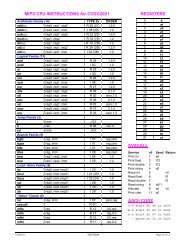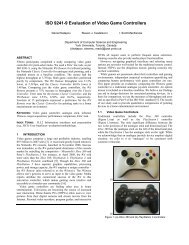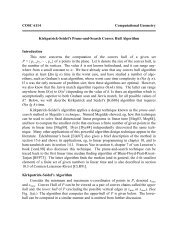You also want an ePaper? Increase the reach of your titles
YUMPU automatically turns print PDFs into web optimized ePapers that Google loves.
<strong>Gabor</strong> <strong>filters</strong><br />
Konstantinos G. Derpanis<br />
<strong>York</strong> <strong>University</strong><br />
kosta@cs.yorku.ca<br />
Version 1.3<br />
April 23, 2007<br />
In this note the <strong>Gabor</strong> filter is reviewed. The <strong>Gabor</strong> filter was originally introduced<br />
by Dennis <strong>Gabor</strong> (<strong>Gabor</strong>, 1946). The one-dimensional <strong>Gabor</strong> filter is defined as the<br />
multiplication of a cosine/sine (even/odd) wave with a Gaussian windows (see Fig.<br />
1), as follows,<br />
ge(x) = 1 x2<br />
−<br />
√ e 2σ<br />
2πσ 2 cos(2πω0x) (1)<br />
go(x) = 1 x2<br />
−<br />
√ e 2σ<br />
2πσ 2 sin(2πω0x) (2)<br />
where ω0 defines the centre frequency (i.e., the frequency in which the filter yields<br />
the greatest response) and σ the spread of the Gaussian window.<br />
The power spectrum of the <strong>Gabor</strong> filter is given by the sum of two Gaussians<br />
centred at ±ω0:<br />
G(ω) = e −2π2σ2 (ω−ω0) 2<br />
+ e −2π2σ2 (ω+ω0) 2<br />
(3)<br />
This can be reasoned as follows. The power spectrum of a sine wave are two impulses<br />
located at ±ω0 and the power spectrum of Gaussian is a (non-normalized) Gaussian.<br />
Multiplication in the temporal (spatial) domain is equivalent to convolution in the<br />
frequency domain (Oppenheim, Willsky & S.H., 1997).<br />
The uncertainty principle states that the product of the spread (i.e., uncertainty)<br />
of a signal in the time and frequency domains must exceed or equal a fixed constant,<br />
△t△f = c, (4)<br />
where c 1 is a constant, △t and △f represent the measure of the spread of the signal<br />
in the time and frequency domains, respectively (see Fig. 2). The implication of this<br />
1 The exact value of the constant c depends on the form of the Fourier transform used.<br />
1
0.4<br />
0.3<br />
0.2<br />
0.1<br />
0<br />
−0.1<br />
−0.2<br />
0<br />
−6 −4 −2 0<br />
x<br />
2 4 6<br />
(a) <strong>Gabor</strong> cosine (even)<br />
0.3<br />
0.2<br />
0.1<br />
0<br />
−0.1<br />
−0.2<br />
−0.3<br />
0<br />
−6 −4 −2 0<br />
x<br />
2 4 6<br />
(b) <strong>Gabor</strong> sine (odd)<br />
Figure 1: One-dimensional <strong>Gabor</strong> <strong>filters</strong>.<br />
principle is that the accuracy with which one can measure a signal in one domain limits<br />
the attainable accuracy of the measurement in the other domain. <strong>Gabor</strong> (<strong>Gabor</strong>,<br />
1946) demonstrated that the complex <strong>Gabor</strong> filter given by,<br />
g(x) =ge(x) + igo(x)<br />
= 1 x2<br />
−<br />
√ e 2σ<br />
2πσ 2<br />
= 1 x2<br />
−<br />
√ e 2σ<br />
2πσ 2 e i(2πω0x)<br />
<br />
cos(2πω0x) + i sin(2πω0x)<br />
attains the optimal (lower bound) compromise between the localization in the time<br />
and frequency domains; notice that the Gaussian function is an instance of a <strong>Gabor</strong><br />
filter with centre frequency ω0 = 0. Note that the constituent real-valued <strong>Gabor</strong><br />
elementary functions (i.e., the even and odd part taken separately) do not as widely<br />
believed minimize the joint uncertainty (Stork & Wilson, 1990). Furthermore, the<br />
selection of a different localization measure may result in a different class of “optimal”<br />
function altogether (Lerner, 1961; Stork & Wilson, 1990), casting doubt on the<br />
primacy of the <strong>Gabor</strong> function often cited in the literature.<br />
Daugman (Daugman, 1980; Daugman, 1985) extended the <strong>Gabor</strong> filter to twodimensions<br />
(see Fig. 3), as follows,<br />
1<br />
ge(x, y) = e<br />
2πσxσy<br />
1<br />
go(x, y) = e<br />
2πσxσy<br />
<br />
(5)<br />
1 x2 y2<br />
− ( + 2 σx σy ) cos(2πωx0x + 2πωy0y) (6)<br />
1 x2 y2<br />
− ( + 2 σx σy ) sin(2πωx0x + 2πωy0y) (7)<br />
where (ωx0, ωy0) defines the centre frequency and (σx, σy) the (potentially asymmetric)<br />
spread of the Gaussian window.<br />
2
frequency<br />
domain<br />
ω<br />
ΔtΔf<br />
≥ c<br />
time<br />
domain<br />
Figure 2: Joint localization of a signal in time and frequency domains.<br />
For the purpose of extracting optical flow, Heeger (Heeger, 1987) utilized the<br />
three-dimensional (space-time) <strong>Gabor</strong> filter,<br />
ge(x, y, t) =<br />
go(x, y, t) =<br />
1<br />
(2π) 3/2 σxσyσt<br />
1<br />
(2π) 3/2 σxσyσt<br />
1 x2 y2 t2<br />
− ( + + ) 2 σx σy σt cos(2πωx0x + 2πωy0y + 2πωt0t) (8)<br />
e<br />
1 x2 y2 t2<br />
− ( + + ) 2 σx σy σt sin(2πωx0x + 2πωy0y + 2πωt0t) (9)<br />
e<br />
where (ωx0, ωy0, ωt0) defines the centre frequency and (σx, σy, σt) defines the (potentially<br />
asymmetric) spread of the Gaussian window.<br />
Heeger (Heeger, 1987) demonstrated that the three-dimensional (similarly for the<br />
two-dimensional case) <strong>Gabor</strong> filter can be built from one-dimensional separable components.<br />
Considering the two-dimensional <strong>Gabor</strong> filter, let k be the size of the twodimensional<br />
convolution kernel and n be the size of an image (in pixels). The complexity<br />
of the non-separable convolution of the <strong>Gabor</strong> filter is reduced from O(k 2 n 2 )<br />
to O(kn 2 ).<br />
An application of <strong>Gabor</strong> <strong>filters</strong> is in local time-frequency analysis of signals, specifically,<br />
a fixed windowed Fourier transform, referred to as the <strong>Gabor</strong> transform. A<br />
difficulty with the <strong>Gabor</strong> transform is that it is linearly independent but highly nonorthogonal<br />
and as such cannot be easily inverted. As a result of non-orthogonality,<br />
3<br />
t
the functions, ri(n), used for reconstructing the discrete signal, f(n), are highly distinct<br />
from the <strong>Gabor</strong> functions used to recover the coefficients of the representation<br />
(i.e., the analysis step), where the coefficients indicate how much of its corresponding<br />
reconstruction filter, ri(n), is to be added, formally,<br />
f(n) = <br />
ciri(n) reconstruction step (10)<br />
where,<br />
i<br />
ci = <br />
f(n)gi(n) analysis step. (11)<br />
n<br />
If the <strong>Gabor</strong> transform were indeed orthogonal (such as the Fourier transform),<br />
gi(n) = ri(n).<br />
References<br />
Daugman, J. (1980). Two-dimensional analysis of cortical receptive field profiles.<br />
Vision Research, 20, 846–856.<br />
Daugman, J. (1985). Uncertainty relation for resolution in space, spatial frequency,<br />
and orientation optimized by two-dimensional visual cortical <strong>filters</strong>. Journal of<br />
the Optical Society of America-A, 2(7), 1160–1169.<br />
<strong>Gabor</strong>, D. (1946). Theory of communication. Journal of the Institute of Electrical<br />
Engineers, 93, 429–457.<br />
Heeger, D. (1987). Model for the extraction of image flow. Journal of the Optical<br />
Society of America-A, 2(2), 1455–1471.<br />
Lerner, R. (1961). Representation of signals. In E. Baghdady (Ed.), Lectures on<br />
Communication System Theory chapter 10, (pp. 203–242). Mc-Graw-Hill.<br />
Oppenheim, A., Willsky, A. & S.H., N. (1997). Signals and Systems. Upper Saddle<br />
River, NJ: Prentice Hall.<br />
Stork, D. & Wilson, H. (1990). Do <strong>Gabor</strong> functions provide appropriate descriptions<br />
of visual cortical receptive fields? Journal of the Optical Society of America-A,<br />
7(9), 1362–1373.<br />
4
8<br />
6<br />
4<br />
2<br />
0<br />
0.2<br />
0.15<br />
0.1<br />
0.05<br />
0<br />
−0.05<br />
−0.1<br />
−0.15<br />
−0.2<br />
−1<br />
−4<br />
−0.5<br />
−2<br />
0<br />
0<br />
x<br />
0.5<br />
ω x<br />
2<br />
4−4<br />
−2<br />
(a) <strong>Gabor</strong> cosine (even)<br />
1<br />
−1<br />
0<br />
y<br />
−0.5<br />
(b) <strong>Gabor</strong> power spectrum<br />
Figure 3: Two-dimensional <strong>Gabor</strong> <strong>filters</strong>.<br />
5<br />
ω y<br />
0<br />
2<br />
0.5<br />
1<br />
4













